During the just-ended ‘Our Bus Journey’ carnival organized by LTA, two concept double-decker buses were put on display, providing a glimpse of what buses will be like in the near-future. The buses are specially designed to improve commuter flow and minimize bus stop dwell time, as well as to improve the overall commuting experience.
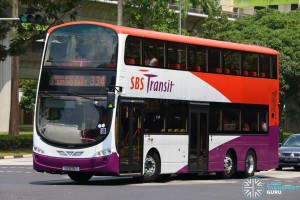
Double-decker buses have poor passenger flow when there are many passengers wanting to board and alight at a bus stop. Current double decker buses have only one staircase and two doors, resulting in a bottleneck between the front and the back door, where boarding passengers are required to wait for all alighting passengers from the upper deck to disembark before being are able to move further inside the bus. A 2014 study also concluded that the time taken for a passenger to alight from a double-decker is 0.2 seconds longer than from a single-deck bus, resulting in longer bus stop dwell times.
These two concept buses, namely an Alexander Dennis Enviro500 and a MAN Lion’s City DD L, offer ideas on how to mitigate this age-old problem and are a result of LTA’s efforts to improve passenger flow and movement within the bus as well as in and out of a double decker bus. Both buses are fundamentally similar, featuring the addition of a second staircase as well as a third exit door to improve passenger flow. However, the design of both buses reflect different interpretations and applications of the above idea, positioning the staircases and exit doors differently.
The buses also have new features to improve the bus commuting experience, such as USB ports, headrests, passenger information displays, bus stop announcements and colored Electronic Display Signages (EDSes).
First, we shall illustrate the differences between the two buses.
| MAN Lion’s City DD L | |
| Advantages | Disadvantages |
Staircases
Third Door
Others
|
Third Door
Others
|
Suggestions for the MAN Lion’s City DD L’s design:
- Entrance doors should revert to double-leaf doors similar to those found on SMRT’s MAN A22/A24/A95 buses
- Prominent signs and posters to educate commuters on the proper usage of staircases and exits, as this design is an entirely new and unfamiliar (by no means bad), as compared to the Alexander Dennis design, which retains more familiar characteristics.
| Alexander Dennis Enviro500 | |
| Advantages | Disadvantages |
Staircases
Third Door
Others
|
Staircases
Others
|
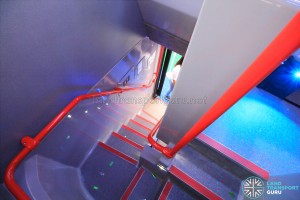
Suggestions for the Alexander Dennis Enviro500’s design:
- Posters and signs can be put up to encourage passengers to use the rear staircase
- Third exit could consist of only a single leaf sliding plug door instead of a full set of sliding plug doors currently being demonstrated, to reduce the length of the rear overhang.
- Putting spring barriers at the rear section of the Alexander Dennis Enviro500, working in the same manner as on the MAN Lion’s City DD L
- Reduce rear overhang length by relocating drivetrain components below the stairs
In addition, the MAN Lion’s City DD L has television screens as part of the passenger information display system which was not present in the Enviro500 mockup. Supplementary features offered by MAN were touch activated bus stop buttons, as well as an unsafe driver behavior detection system designed to prevent accidents by detecting mobile usage and micro-sleeping behaviour.

Meanwhile, the Alexander Dennis Enviro500 has LED lights along the exits, cabin floor and the staircase floor to improve user visibility and safety.
In Summary:
The most compelling feature is likely the new bus stop announcement system, similar to bus stop announcement systems currently used on buses in other major Asian cities. For comparison, Hong Kong, a city heavily reliant on buses, has next stop announcements on nearly all public buses. Of note is the Telargo system used on Citybus/New World First Bus buses, which integrates GPS bus tracking and keeps buses in contact with the Operations Control Centre. Information is fed to bus stop displays and next stop announcements which can be configured with additional en-route announcements used for both passenger reminders and commercial advertising. In addition, the system automatically updates itself over a Wi-Fi network installed within bus depots.
Previously, buses had no bus stop announcement systems, and only Passenger Information System screens were available on newer SMRT buses to display the upcoming bus stops. Since 1 April 2016, LTA has been rolling out new equipment on buses with bus stop announcements, and the full capabilities of the new system have yet to be proven on revenue service.
However, bells and whistles such as USB ports and touch activated bus stop buttons should not be implemented if installation costs are high and if there is no guarantee they will be properly maintained. This is especially important for the USB ports as they can potentially cause accidents through electrical fire.
MAN Lion’s City DD L design VS Alexander Dennis Enviro 500 design:
Basis of comparison: Location of second staircase, location of third door, ease of boarding and alighting, ease of passenger flow, ease of driving, ease of fleet integration, passenger capacity, possibility of fare evasion through third door.
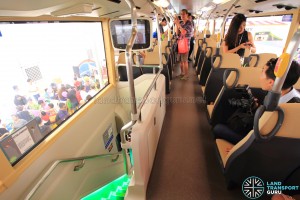
- Location of second staircase: MAN Lion’s City DD L
The MAN’s second staircase is more accessible to upper deck passengers compared to the Alexander Dennis’ second staircase.
- Location of third door: Alexander Dennis Enviro500
The location of the Alexander Dennis’ third door is more conventional for a 3 door, 2 staircase bus (like the New Bus for London), while users of the MAN may initially encounter some confusion over the usage of the third door.
- Ease of boarding and alighting: MAN Lion’s City DD L
The MAN allows for easier boarding and alighting as compared to the Alexander Dennis, as the staircases on the MAN are clearly demarcated for going up and going down respectively. Both the lower and upper deck also have exit doors for their exclusive use. In contrast, on the Alexander Dennis, the second and third doors can be used by both upper-deck and lower-deck passengers. The passenger flow is also not clearly demarcated, and lower-deck passengers can use the rear staircase to access the upper-deck, resulting in competing door and staircase usage.
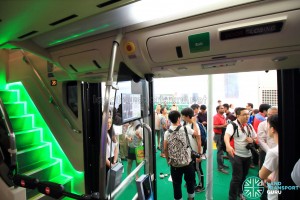
- Ease of passenger flow: Tie
On the MAN, people on the lower deck could have more incentive to move up due to the perception of easier exit with a dedicated second staircase and exit door. However, there is little incentive to move to the rear of the lower deck as the exit is located in the middle of the bus. On the Alexander Dennis, people on both the lower deck and upper deck have an incentive to move to the rear of the bus due to the presence of a second staircase and a third exit there. However, there isn’t exactly an incentive for people to move to the upper deck, only towards the rear of the bus.
- Ease of driving: MAN Lion’s City DD L
The MAN Lion’s City DD L is slightly shorter at 12.8m as compared to the Alexander Dennis Enviro500 at 13.0m. Critically, the rear overhang of the MAN Lion’s City DD L is shorter with greater ground clearance, reducing the need for the driver to be extra cautious of the rear sweep radius as well as providing greater ease of driving over ground obstacles such as road humps.
-

SMRT MAN A95 (SMB5899B) – Service 860 Ease of fleet integration: MAN Lion’s City DD L
The MAN Lion’s City DD L has a high parts commonality with the extremely large existing MAN fleet in Singapore, namely the MAN A22, MAN A24 and the MAN A95, totaling more than 700 buses. This benefits operators (and LTA) with the advantage of having better economies of scale in areas such as spare part procurement and maintenance simplification. In contrast, the Alexander Dennis Enviro500 suffers from being relatively small in numbers currently (only 201 units operating with SMRT) as compared to the MAN. Such a small fleet prevents operators from enjoying better economies of scale and purchasing Alexander Dennis Enviro500s, as compared to buying more MAN buses in the form of MAN Lion’s City DD Ls.
- Passenger capacity: MAN Lion’s City DD L
MAN Lion’s City DD L has a slightly higher seating capacity than the Alexander Dennis Enviro500 (74 vs 72), even without taking into account the foldable seats.
- Possibility of fare evasion through the third door: MAN Lion’s City DD L
The narrower third door of the MAN prevents fare evaders from entering the bus as one would have to go against the flow of passengers alighting from the upper deck. The central location of the third door also allows the driver to better monitor and see the third door. In contrast, without an inspector, the full-sized third door of the Alexander Dennis allows more space for fare evaders to board the bus, and the driver has the additional burden of monitoring a CCTV due to the third door being all the way at the back.
Overall preference: MAN Lion’s City DD L
Ultimately, public preference in bus design and configuration would a key factor in the decision making of the Land Transport Authority.
This article is written by Omnibology SG, an independent Facebook page providing news updates and infographics on Singapore’s buses.
If you like to contribute articles to Land Transport Guru, feel free to drop us a message through our Facebook page or the Contact Us form located at the bottom of the page.
References
See Also
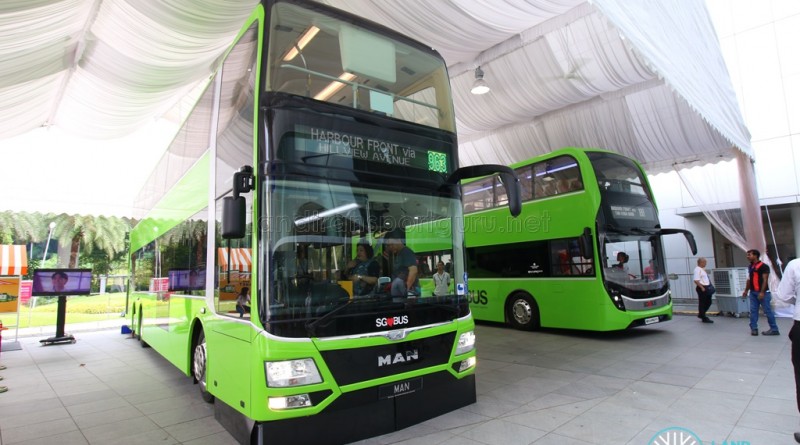
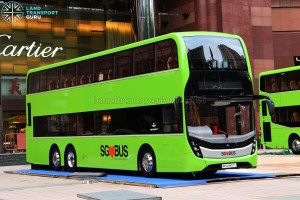

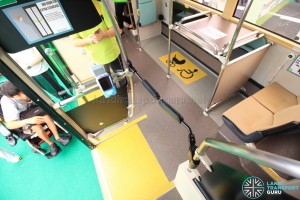
This 13m concept bus should be fitted with the Cummins 380hp/1700nm instead and the A95 12.8m shoud opt for 360hp
Seriously there is not much differences in driving 12.8 or 13.0 m buses,Both are challenging in space war SG roads..The MAN should have just third door and not those side by side and front single door while the ADL rear is too flat making it prone to hit barriers/Trees during reverse parking.
I didn’t wish to have a second staircase/third door though